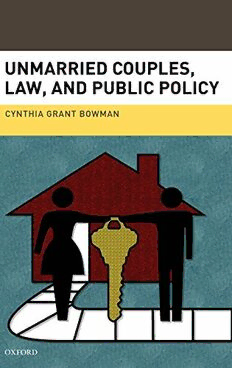
Unmarried Couples, Law, and Public Policy PDF
Preview Unmarried Couples, Law, and Public Policy
Unmarried Couples, Law, and Public Policy This page intentionally left blank Unmarried Couples, Law, and Public Policy cynthia grant bowman 1 1 Oxford University Press, Inc., publishes works that further Oxford University’s objective of excellence in research, scholarship, and education. Oxford New York Auckland Cape Town Dar es Salaam Hong Kong Karachi Kuala Lumpur Madrid Melbourne Mexico City Nairobi New Delhi Shanghai Taipei Toronto With offices in Argentina Austria Brazil Chile Czech Republic France Greece Guatemala Hungary Italy Japan Poland Portugal Singapore South Korea Switzerland Thailand Turkey Ukraine Vietnam Copyright © 2010 by Oxford University Press, Inc. Published by Oxford University Press, Inc. 198 Madison Avenue, New York, New York 10016 Oxford is a registered trademark of Oxford University Press Oxford University Press is a registered trademark of Oxford University Press, Inc. All rights reserved. No part of this publication may be reproduced, stored in a retrieval system, or transmitted, in any form or by any means, electronic, mechanical, photocopying, recording, or otherwise, without the prior permission of Oxford University Press, Inc. ____________________________________________ Library of Congress Cataloging-in-Publication Data Bowman, Cynthia Grant, 1945– Unmarried couples, law, and public policy / Cynthia Grant Bowman. p. cm. Includes bibliographical references and index. ISBN 978-0-19-537227-4 (hardback) : alk. paper) 1. Unmarried couples—Legal status, laws, etc.—United States. 2. Unmarried couples—Social aspects—United States. 3. Unmarried couples—Legal status, laws, etc. I. Title. KF538.B69 2010 346.7301’6—dc22 2009041113 ____________________________________________ 1 2 3 4 5 6 7 8 9 Printed in the United States of America on acid-free paper Note to Readers Th is publication is designed to provide accurate and authoritative information in regard to the subject matter covered. It is based upon sources believed to be accurate and reliable and is intended to be current as of the time it was written. It is sold with the understanding that the publisher is not engaged in rendering legal, accounting, or other professional services. If legal advice or other expert assistance is required, the services of a competent professional person should be sought. Also, to confi rm that the information has not been aff ected or changed by recent developments, traditional legal research techniques should be used, including checking primary sources where appropriate. (Based on the Declaration of Principles jointly adopted by a Committee of the American Bar Association and a Committee of Publishers and Associations.) You may order this or any other Oxford University Press publication by visiting the Oxford University Press website at www.oup.com To Ben This page intentionally left blank Contents Preface and Acknowledgments xi Introduction 1 chapter 1 Cohabitation in the United States: Th e Past 11 1. Criminalization of Cohabitation 12 2. Common Law Marriage and Related Fictions 21 3. Denial of Benefi ts to Cohabitants: A Case Study of Illinois 28 4. Th e Inadequacy of Equitable Remedies 38 chapter 2 Legal Treatment of Cohabitation in the United States Today 47 1. Cohabitants’ Rights Based on Contract 47 2 . Cohabitants’ Rights Based on Status 5 3 2.1. Meretricious Relationships in Washington 54 2.2. Domestic Partnership Laws 5 9 3. Rights Against Th ird Parties 69 3.1. Benefi ts from the State 70 3.2. Tort Claims Against Th ird Parties 73 3.3. Health-Related Benefi ts 78 4. Cohabitants and Th eir Children 80 chapter 3 Cohabitation in the United States Today 93 1. Th e 1960s 93 2. Change over Time 97 2.1. Statistics 97 2.2. Rate and Age of Marriage 99 2.3. Predictions 101 vii viii contents 3. Who Cohabits and Why? 102 3.1. College Students and Young Dating Singles 102 3.2. Variations by Income 1 06 3.3. Variation by Race and Ethnic Group: African Americans 111 3.4. Variation by Race and Ethnic Group: Latino/as 114 3.5. Divorced Persons 117 3.6. Th e Elderly 118 3.7. Other Characteristics 121 chapter 4 Social Science and Cohabitation 125 1. Th e Pioneers 125 2. Trends in the Literature 1 27 3. What Social Science Has Told Us About Cohabitation 131 3.1. Duration of Cohabiting Unions 131 3.2. Th e Economics of Cohabiting Relationships 138 3.2.1. Management of Money Within Cohabiting Relationships 138 3.2.2. Th e Impact of Cohabitation Upon the Economic Well-being of the Partners and Th eir Children 142 3.2.3. Division of Household Labor Between Cohabitants 1 43 3.3. Quality of the Relationship 146 3.4. Domestic Violence and Cohabitation 151 3.5. Impact of Cohabitation on Children 1 58 3.6. What We Know: A Summary 167 4. Implications of the Social Science Findings 169 chapter 5 Treatment of Cohabitation in Other Nations 173 1. England: Nonrecognition and Piecemeal Benefi ts 175 2. Canada: Th e New Common Law Marriage? 186 3. De Facto Relationships in Australia 194 4. Th e Netherlands: A Cafeteria Approach to Cohabitants’ Rights 201 5. France: Concubinage and the Pacte Civil de Solidarité 206 6. Sweden and Neutrality Between Cohabitation and Marriage 214 contents ix chapter 6 A New Law for Cohabitants in the United States 221 1. Recommendations for Reform of U.S. Law 223 1.1. Imposition by Law of Quasi-marital Status on Cohabitants After Two Years or a Child 224 1.2. Th e Ability of Cohabitants to Contract Out of Obligations 228 1.3. A System of Registration for Domestic Partnerships 229 2. Th e Impact of the Proposed Reforms on Marriage 230 2.1. Incentives and Marriage 231 2.2. Cross-historical and Cross-national Comparisons 234 3. Th e Impact of the Proposed Reforms on Various Groups of Cohabitants 239 Conclusion 2 43 References 245 Index 267
